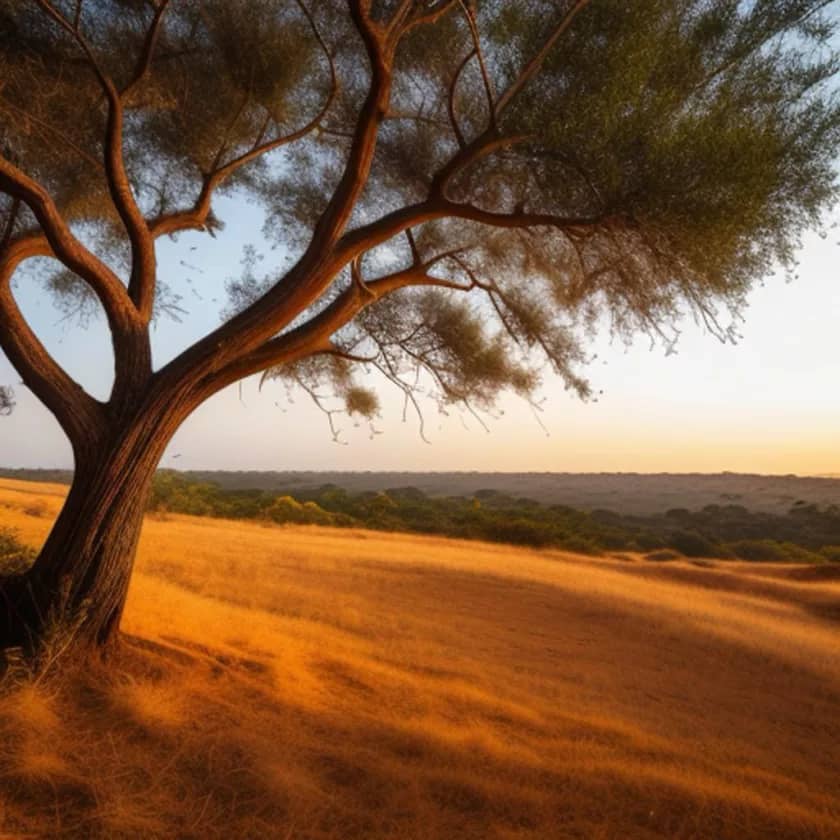
Santalum spp
Sandalwood trees hold spiritual importance in Hinduism and Buddhism. The fragrant wood is used in rituals, meditation, and the creation of sacred objects.
Sandalwood trees, belonging to the genus Santalum, are indeed highly regarded in Hinduism and Buddhism for their spiritual and aromatic significance. Here are some key points about the sandalwood tree and its significance in these religions:
- Sacred Wood: The heartwood of the sandalwood tree is highly valued for its sweet and fragrant aroma. It is often referred to as “Chandan” in India and has been used for centuries in religious ceremonies and rituals.
- Religious Significance:
- Hinduism: Sandalwood holds a prominent place in Hindu religious practices. It is used in the form of paste or oil to anoint idols, especially during puja (worship) ceremonies. Sandalwood paste is also applied on the foreheads of devotees, symbolizing purity and spirituality. The fragrance of sandalwood is believed to be pleasing to the deities.
- Buddhism: Sandalwood is also significant in Buddhism, particularly in Tibetan Buddhism. It is used as incense in rituals and meditation practices. The scent is believed to aid in creating a conducive environment for meditation and enhancing concentration.
- Creation of Sacred Objects: Sandalwood is often used to carve sacred objects, such as prayer beads (malas) and figurines of deities. These objects are considered not only religious but also spiritually potent, and the presence of sandalwood is believed to enhance their sanctity.
- Traditional Medicine: In addition to its religious uses, sandalwood is also known for its medicinal properties in Ayurvedic and traditional Chinese medicine. It has been used to treat various ailments and skin conditions.
- Conservation Concerns: Due to overharvesting and illegal trade, many species of sandalwood are endangered. Efforts have been made to protect and sustainably manage sandalwood resources to ensure their availability for future generations.
In summary, sandalwood trees are revered in Hinduism and Buddhism for their aromatic wood, which plays a central role in religious rituals, meditation practices, and the creation of sacred items. The fragrance of sandalwood is associated with purity and spirituality in these religions, making it a cherished and valuable natural resource.

Species, characteristics, botanical information, use, ecological importance
Sandalwood refers to a group of aromatic trees and shrubs belonging to the genus Santalum. There are several species of sandalwood, but the most well-known and economically valuable species include Santalum album (Indian sandalwood) and Santalum spicatum (Australian sandalwood). Here’s more information about these species, their characteristics, botanical details, uses, and ecological importance:
Indian Sandalwood (Santalum album):
Characteristics:
- Indian sandalwood is a small to medium-sized evergreen tree, typically reaching heights of 4 to 9 meters (13 to 30 feet).
- It has leathery leaves, small flowers, and produces small, spherical, fleshy fruits.
- The heartwood of Indian sandalwood is highly aromatic and has a sweet, woody fragrance.
- The wood is light yellow to brownish-red in color.
Botanical Information:
- Scientific Name: Santalum album
- Family: Santalaceae
- Native Range: Indian subcontinent, including India, Sri Lanka, and Nepal.
Uses:
- Indian sandalwood is primarily valued for its fragrant heartwood, which is used to extract sandalwood oil. This oil is used extensively in perfumes, cosmetics, and aromatherapy due to its pleasant aroma.
- Sandalwood paste, made from the heartwood, is used in religious rituals and ceremonies in Hinduism and other cultures.
- The wood is also used in carving sacred objects, sculptures, and high-quality furniture.
Ecological Importance:
- Sandalwood trees play a role in stabilizing soil and preventing erosion due to their root systems.
- They provide habitat and food for various wildlife species.
- Indian sandalwood is currently endangered in the wild due to overharvesting for its valuable heartwood. Conservation efforts are in place to protect and preserve this species.
Australian Sandalwood (Santalum spicatum):
Characteristics:
- Australian sandalwood is a small to medium-sized tree or shrub, typically reaching heights of 2 to 6 meters (6 to 20 feet).
- It has narrow, elliptical leaves and produces small, inconspicuous flowers.
- The heartwood is fragrant and valued for its aromatic oil.
Botanical Information:
- Scientific Name: Santalum spicatum
- Family: Santalaceae
- Native Range: Western Australia.
Uses:
- Australian sandalwood is primarily harvested for its aromatic heartwood, from which sandalwood oil is extracted. This oil is used in perfumery, cosmetics, and traditional medicine.
- Like Indian sandalwood, Australian sandalwood wood is also used for carving, particularly in the production of handicrafts and traditional objects.
Ecological Importance:
- Australian sandalwood is an important component of the ecosystems in Western Australia, providing habitat and sustenance for various flora and fauna.
- Sustainable harvesting and cultivation of Australian sandalwood are important for maintaining ecological balance in its native habitat.
Both Indian and Australian sandalwood species are valued for their aromatic properties and are economically significant due to their uses in the fragrance industry. However, conservation efforts are essential to protect these species from overexploitation and habitat loss, as they are slow-growing and vulnerable to depletion in the wild.
Table summarizing the information about Indian Sandalwood (Santalum album) and Australian Sandalwood (Santalum spicatum) based on their characteristics, botanical information, uses, and ecological importance
| Aspect | Indian Sandalwood (Santalum album) | Australian Sandalwood (Santalum spicatum) |
| Characteristics | – Small to medium-sized evergreen tree | – Small to medium-sized tree or shrub |
| – Height: 4 to 9 meters (13 to 30 feet) | – Height: 2 to 6 meters (6 to 20 feet) | |
| – Leathery leaves | – Narrow, elliptical leaves | |
| – Small flowers | – Inconspicuous flowers | |
| – Heartwood with sweet, woody fragrance | – Aromatic heartwood | |
| – Light yellow to brownish-red wood | ||
| Botanical Information | – Scientific Name: Santalum album | – Scientific Name: Santalum spicatum |
| – Family: Santalaceae | – Family: Santalaceae | |
| – Native Range: Indian subcontinent | – Native Range: Western Australia | |
| Uses | – Sandalwood oil for perfumes, cosmetics, | – Sandalwood oil for perfumery, cosmetics, |
| and aromatherapy | and traditional medicine | |
| – Sandalwood paste in religious rituals | – Wood used in carving and handicrafts | |
| – Carving sacred objects and furniture | ||
| Ecological Importance | – Stabilizes soil, prevents erosion | – Supports native ecosystems in Western |
| – Provides habitat and food for wildlife | Australia | |
| – Endangered due to overharvesting | – Sustainable harvesting and cultivation | |
| – Conservation efforts in place | for ecological balance |
Please note that the table provides a concise summary of the key aspects of these two sandalwood species, and there may be additional details and variations depending on specific sub-species and local factors.

The scent of sandalwood
The scent of sandalwood is highly regarded and cherished for its unique and pleasant aroma. Here are some key characteristics of the scent of sandalwood:
- Sweet and Woody: Sandalwood has a sweet, woody fragrance that is often described as warm and soothing. This fragrance is at the heart of its popularity in perfumery, aromatherapy, and religious rituals.
- Long-Lasting: Sandalwood’s aroma is known for its longevity. It can persist for hours or even days, which makes it a valuable base note in perfumes and incense.
- Earthy and Creamy: Along with its sweet woody notes, sandalwood also has earthy and creamy undertones. These aspects of its scent add depth and complexity to its aroma.
- Balancing and Relaxing: Sandalwood’s fragrance is believed to have calming and balancing effects on the mind and emotions. It is often used in aromatherapy to promote relaxation, reduce stress, and enhance meditation.
- Versatile: Sandalwood’s versatility in blending with other scents makes it a popular choice in creating fragrances. It can complement a wide range of other essential oils and aromatic compounds.
- Spiritual and Cultural Significance: Beyond its aromatic qualities, sandalwood holds cultural and spiritual importance in many traditions, including Hinduism and Buddhism, where it is associated with purity, spirituality, and reverence.
- Traditional and Modern Uses: Sandalwood is used in a variety of products, including perfumes, colognes, candles, incense, soaps, cosmetics, and even air fresheners. It is also applied as a paste in religious ceremonies and rituals.
Overall, the scent of sandalwood is treasured for its soothing, harmonizing, and timeless qualities, making it a sought-after fragrance in various aspects of life, from personal care products to spiritual practices.
Botanicus Plus a GPT for starters and experts
Botnicus Plus boasts an array of new features, enhancing its global appeal and user interaction. These include: 1) Multilingual Support for accessibility in various languages. 2) Virtual Tours of famous botanical gardens and historical plant sites. 3) A Botanical Identification Tool for users to upload and identify plants. 4) Seasonal Guides and Tips tailored to local climates and regions. 5) Opportunities for users to engage in Collaborative Projects and Citizen Science Initiatives. 6) Advice on Sustainable Gardening Practices. 7) Interactive Q&A Sessions with botany experts. 8) Personalized Plant Care Reminders for gardeners. These features enrich Botnicus Plus’s mission to provide comprehensive, interactive, and culturally rich botanical education, fostering a deeper connection with the natural world.
Enjoy!👒
Source OpenAI’s chatGPT Language Models, Dalle, AI trot and Fleeky
images Picsart and MIB
Invest in your future
Take time to learn
Embark on your journey in affiliate marketing and website creation alongside an incredible community and myself. Invest in your future by dedicating time to learn and earn. Take all the time you need to master the basics before aiming higher. Give it a try and sign up for free. You won't regret it! Discover the possibilities for yourself...


